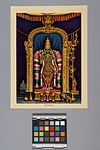Meenakshi
About this object
History of use
Indian popular religious prints have been published for nearly a century, first by German presses, later by Indian ones. The prints may take the form of calendars, posters, or simply images. The style of the representations is European. In the beginning they were Hindu images, but are now acquiring elements both of folk art and a romantic secularism. It is a living art currently influenced by the movie industry and non-Hindu religions. The images are a vehicle for advertising and are also used for religious purposes. This print is used for puja.
Cultural context
calendar art; popular religious art
Iconographic meaning
Representation of Meenakshi, the fish-eyed goddess, as seen in her temple. Ganesh, the remover of obstacles, and the figure of an ordinary woman are present. As a patron deity, Meenakshi is linked with representing poverty. Her symbol is the parrot.
Physical description
Rectangular shaped print of Meenakshi wearing a red and gold sari. Her face is green with a yellow horizontal line and a third eye on her forehead. She is adorned with gold including a headpiece. Her left arm is raised and left hand contains parrot on triangular- shaped object. Right gold arm extends down by side. Woman stands on open, pink lotus placed on top of gold chest and is encircled by striped garland in pink, white, red and green. Behind her is an ornate, gold arch. Placed behind arch's left pillar is elephant-headed male seated on square gold box. Placed in front of pillar on left side is a small statue of Ganesh; on right figure of a woman standing on square gold box. Along the floor are several gold vessels placed in horizontal line; white and gold conch shell on vessel placed in centre of print. Lower left corner contains English, 'Copyright N.S.R. Regunathan, artist, Madurai-1'.
